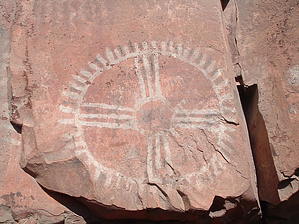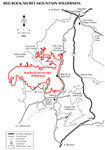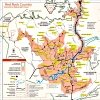| Guide | ♦ | 1 Triplog | 1 Topic |
details | drive | permit | forecast | map |
stats |
photos | triplog | topic | location |
| 23 | 1 | 1 |
Rarely-used trail to an Apache roasting pit. by PaleoRob  Note NoteRarely if ever open to the public. The general Palatki Heritage Site is regularly open. Overview The Agave, a type of yucca, has long been used for food in the southwestern deserts. Before the Anglo settlers came, the ancient Sinagua were harvesting agave hearts and roasting them in pits. After the Sinagua left the Sedona area in the 1300s, the land was vacant. When the Apaches arrived, a few hundred years later, they too realized that the Agave provided an excellent source of sugar and fiber to their diet. So, without knowledge of the Sinagua tradition, they also began gathering Agave's and roasting the Agave hearts in big pits. A few of these pits survive, and probably the best surviving example of an Apache Roasting Pit is occasionally open to the public on the Coconino National Forest.
The Agave Roasting Pit Trail is rarely used by tourists and visitors simply because it is rarely open. The only way you can access this short but fantastic trail is by a docent-led hike, starting from the Palatki Bear Cave rock art site. To get on this hike, a Forest Service employee or volunteer must be willing to lead it. You must have a reservation to visit Palatki on the day the Roasting Pit Trail will be hiked. There is sometimes more than one hike a day, but it is not open every day. The Agave Roasting Pit trail has probably the best rock art on display to the general public in Sedona, hands down. Amazingly detailed polychromatic pictographs dot the cliffs between the Bear Cave and the roasting pit. Your docent should be quite knowledgeable about the rock art along the trail. Some of the designs and figures have no explanation, while others Hopi and Apache elders have looked at and explained to previous archaeologists. The pit itself is enormous. When I was on this trail, and the guide said "pit," I was thinking "hole in the ground." While there is a hole in the ground, it is all covered over by dirt and debris. The Apaches would dig a big hole, tens of feet across, light a fire, and put all their Agave hearts into the pit. Then they would cover the pit back up to trap the heat and roast the hearts. This was a big social event, taking place generally during the winter. The profusion of smoke-blackening from Apache fires and Apache pictographs around the pit bears testimony to that. After several days, the hearts would be dug up, fully roasted, and be passed around and eaten. The pit along this trail, however, was never dug up. There have been core samples taken from the pit that still show Agave hearts located inside. Dating of these hearts and charcoal from the fire seems to indicate that this is one of the spots where the Yavapai Apaches were ambushed in December of 1864 by soldiers from Fort Whipple. Beyond the Agave Pit is a crack in the cliff face, where many pictographs and petroglyphs are located. Some say that this crack, and a boulder near it, were where holy men sat and talked to the gods. There is a pictograph of what may be a snake, dating from Sinagua times, that appears to be going into the rock's crack. This corresponds closely to modern Hopi mythology as snakes are messengers from below the ground, and supernatural snakes living below the earth create springs and rivers. There are still artifacts to be found around the Pit. During our trip, I found a complete Apache arrowhead made of obsidian. The docent was most impressed. If you find anything interesting, tell your guide. They will be very interested, and who knows! Maybe, if they think the artifact is important enough, your name will go on the "discoverer" tag when it goes to the Museum! There is no water along this trail, be sure to fill your water bottles before starting. Water is occasionally available at the Palatki Museum. Check out the Triplog. Leave No Trace and +Add a Triplog after your hike to support this local community. | |||||||||||||||||||||||||||||||||||||||||||||||||||||||||||||||||||||||||||||||||||||||||||||||||||||
 Route Editor
Route Editor









